
Motivation in the Workplace: Where is the Gap?
When we talk about motivation in the workplace, there are several things we need to take into consideration.
Start with the Employer and his/her Expectations from their staff:
- Loyalty
- Honesty
- Productivity
- Harmonious Workplace
- Contribution to the team
This is a general expectation that almost exists without being ‘written down’ and almost never gets communicated to the team. It seems to be a natural thing to expect and there is nothing wrong with these expectations. The problem starts when we just assume that it will fall into place. Unfortunately, it does not always work that way and here is why:
We live in an ever-changing environment, call it evolution if you want, but the bottom line is that people change their personal expectations and we need to keep pace with these changes. There was a time when a ‘decent’ wage was all that was required to have staff reasonably happy and they only left an employer for a better salary offer, or stayed on with a ‘counter offer’.
This method seems to have set itself as the only way to motivate and retain staff, yet, it could not be further from the truth! With the way in which we have changed came a whole new different set of expectations from the employee. These expectations rank higher than the salary itself and you will quite often find that a person left a company for reasons not related to salary at all. In fact, a lot of times the salary was the same or even a little lower!
The same way in which we need to ensure we pace the change within a business with the changes in the market, we also need to understand the changes to our staff’s expectations and ensure we know how to meet these where possible. This is the start of the motivation process. Consider some of the things employees want:
- Sense of belonging
- Recognition
- Being informed (Clear communication)
- Responsibility
- Security
- Approachability (They want their managers to be approachable)
If it is that simple, why are we not doing it? It does seem easy but there is a lot that needs to be in place to fully understand how to address these, as doing it wrong, is as bad as not doing it at all.
The next thing to also understand is the Organisational Influences. Here we will find an array of things that dictates impacts on how we should approach motivation in the workplace. Some of these are:
- Organisational Culture
- Cultural Diversity
- Policies and Procedures
Now things are starting to look a little complicated but fear not. When you start on the path to motivation, make sure you start with the basics and work your way through the rest one item at a time.
What does this mean for the employer, or you may ask: “what is my return on investment”
Start with the BIG one:
Lower staff turnover.
Now we may very well say that everyone can be replaced and although that is true, do you really want to go through the pain of recruiting and re-training constantly? Having a low staff turnover means you have a ‘tight knit’ team that delivers results, and the best part, they enjoy being part of your business!
Spend the time on getting to understand your staff and continually improve their environment to allow them to become a highly-motivated team.
Productivity
You will notice a marked improvement to productivity with a team that is motivated. They start doing things because they want to, not because they must.
Employer Expectations are met
Now that you have a motivated team, check back on the employer’s expectation list and you will find all the boxes are ‘ticked’. In my mind that is the best ROI you can get!
Go back to the opening question: Where is the gap?
The entire missing part is the understanding between the expectations of the employer and employee. If you start addressing these in a structured approach, the results will flow on. Without using an age old ‘cliché’, your staff is truly an investment and should be nurtured. They represent your business and your success is largely dependent on how well they do it.
- Posted by pceadmin
- On December 20, 2016
- 0 Comments


0 Comments